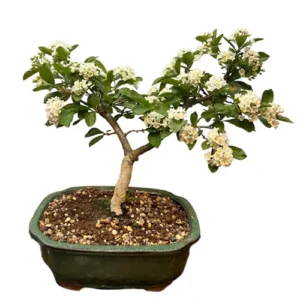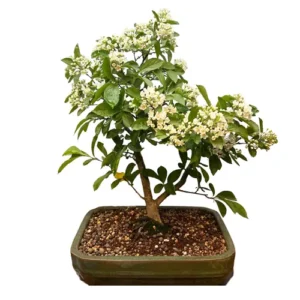Spiraea thunbergii
Spiraea Bonsai
The Spiraea genus of deciduous and semi-evergreen shrubs can be found in thickets, woodland and rocky places across Europe, Asia and Northerly Americas northerly regions. Spiraea thunbergii is a dense, bushy species that is native to Japan and China. In the Spring and early Summer, it displays vibrant white flowers in bowl shaped clusters.
Spiraea Bonsai Care Tips
Placement
Spiraea bonsai requires full sun. They are frost-hardy to -10 degrees C.
Watering
Across the growing season, Spiraea bonsai should be watered daily.
Feeding & Fertilising
A healthy feeding regime for your Spiraea bonsai is every two weeks across the growing season.
Pruning & Wiring
The numerable long shoots that come through in spring should be pruned back hard after flowering to keep the plant’s shape. Once this is done, allow pause pruning to allow further flowering. The process can be repeated in the summer.
Clumps and root-connected Spiraea will respond well to wiring in particular. Extra small to medium species are suitable for a range of styles including slanting, saikei and cascade styles. We also recommend using wires with a thickness that matches the thickness of the branch: if the wire you choose is too thick you will damage the bark. If it is too thin, it won’t be effective.
Repotting
Every other year, when the buds extend in Spring, your Spiraea bonsai should be repotted. A basic soil mix will be appropriate.
Trees that are ready for repotting will require root pruning, a suitable new pot and appropriate soil mix.
When repotting, do not cut back the root mass by a large amount, and choose a well-draining soil mix that has a neutral or slightly higher PH value of 5-6 but not over 7. We tend to use a mixture of different speciality bonsai soils on our trees. Every species is different so please contact us for free soil-mix advice or to take advantage of our repotting service.
Spiraea is a genus of nearly 100 species. Of the two species most used for bonsai, Japanese Spiraea is the other. Also known as Meadowsweets, these deciduous leaved shrubs are found across the Northern Hemisphere but are most diverse in East Asia.
Bonsai trees aren’t only magnificent additions to an indoor oasis, they are more than capable of standing out in any garden. Many Bonsai species are incredibly hardy and withstand nature’s colder and damper turns with aplomb making them worthwhile outdoor plants. We have an extensive library of care guides for outdoor bonsai trees. It’s not about selecting the perfect bonsai, it’s about selecting the perfect bonsai for you.





















